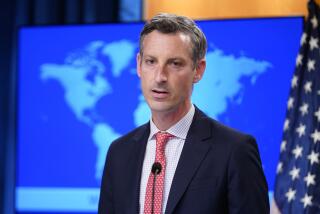U.S. to Review and Update Its Nuclear Weapons Policy
- Share via
WASHINGTON — The Clinton Administration unveiled plans Friday to begin the nation’s first comprehensive review of American nuclear weapons policy since 1981 in an effort to develop a new national doctrine on nuclear warfare tailored to the post-Cold War world.
The review, to be conducted primarily by the Defense Department, will examine the number and kinds of submarines, bombers and intercontinental ballistic missiles remaining in the U.S. nuclear arsenal and the personnel assigned to handle them.
It will also take a new look at the targets at which many of these weapons are aimed. The last such review, completed in 1981, resulted in the targeting of Soviet military facilities and industry that the United States wanted to destroy in the event of all-out war.
Defense Secretary Les Aspin said the exercise--expected to be finished next spring--is intended to reshape U.S. nuclear doctrine for a world in which the nuclear threat from the former Soviet republics is declining, while that from Third World nations is rising.
Aspin said U.S. policy had been based on the concept of amassing a big enough nuclear arsenal to deter the Soviets from launching an all-out attack. But today, the bigger threat is from nuclear weapons held by countries such as North Korea and Iraq.
“The Soviet Union is no more, but the post-Cold War world is decidedly not post-nuclear,” the secretary told reporters at a briefing.
The Administration’s latest effort is intended as a complement to the “bottom-up review” just completed by the Pentagon. It recommended revamping parts of the nation’s armed forces to deal with post-Cold War realities.
But the Pentagon review dealt solely with conventional--or non-nuclear--weapons, and Aspin promised to undertake a separate review to deal with the nation’s nuclear policy. Friday’s announcement is intended to fulfill that pledge.
The United States has about 8,000 nuclear warheads in stock. But it will be able to deploy only 3,500 by the century’s end, when the second Strategic Arms Limitation Treaty signed with Moscow has been fully ratified and put into effect.
U.S. officials said that any recommendations stemming from the review eventually will be submitted to President Clinton for approval. The exercise will be conducted by civilian officials at the Pentagon and high-ranking military officers.
Administration officials said that besides looking at basic strategy, weapons and force structure, the review will deal with counter-proliferation issues, the continued dismantling of former Soviet nuclear weapons and operations and safety. It will also seek to address several fundamental policy issues concerning the use of nuclear weapons by the United States, including:
* How many submarines, bombers and missile crews should be placed permanently on alert, poised for possible nuclear war.
* Whether Washington should pledge that it will not be the first to use nuclear weapons in a conventional conflict.
* Whether the United States should launch nuclear strikes if U.S. troops are attacked with chemical or biological weapons.
More to Read
Sign up for Essential California
The most important California stories and recommendations in your inbox every morning.
You may occasionally receive promotional content from the Los Angeles Times.













